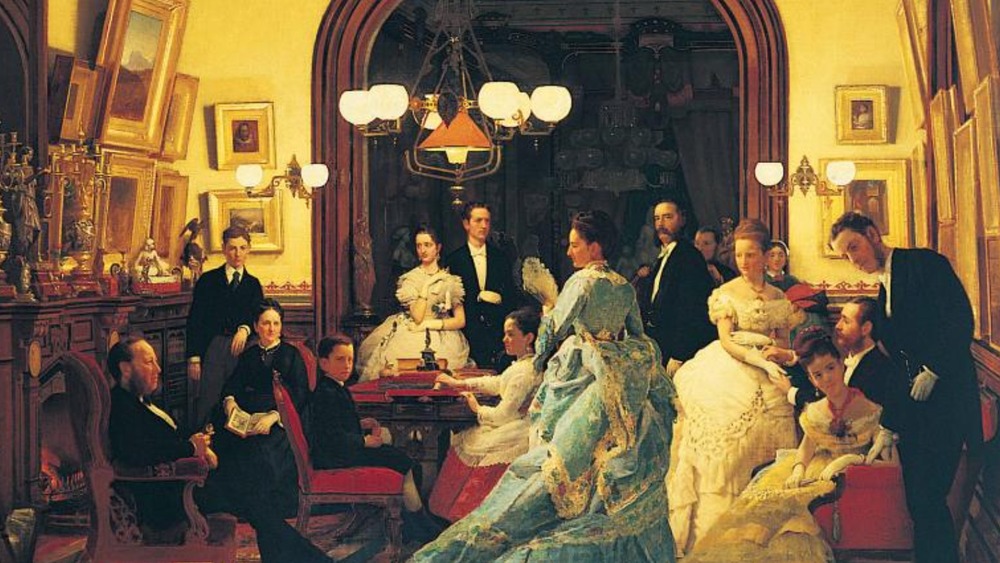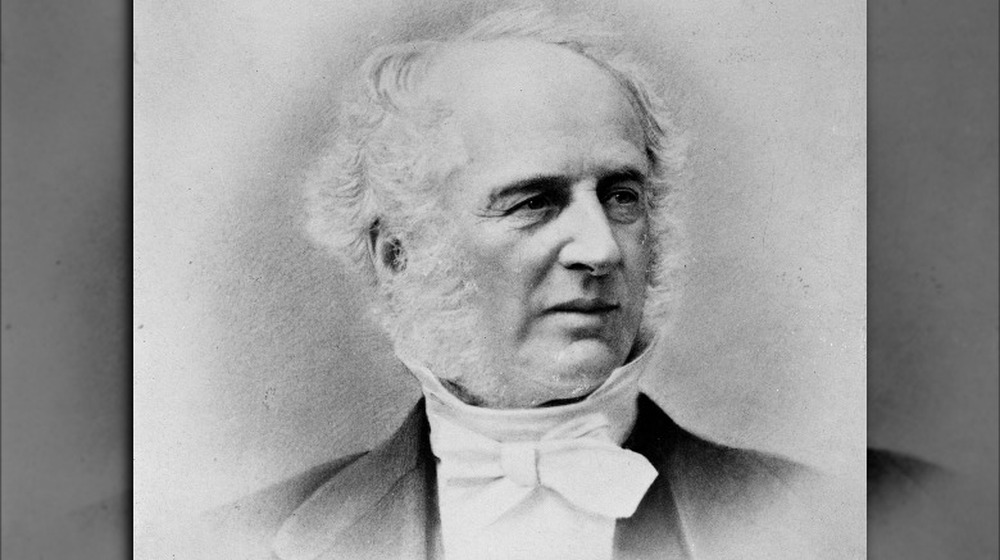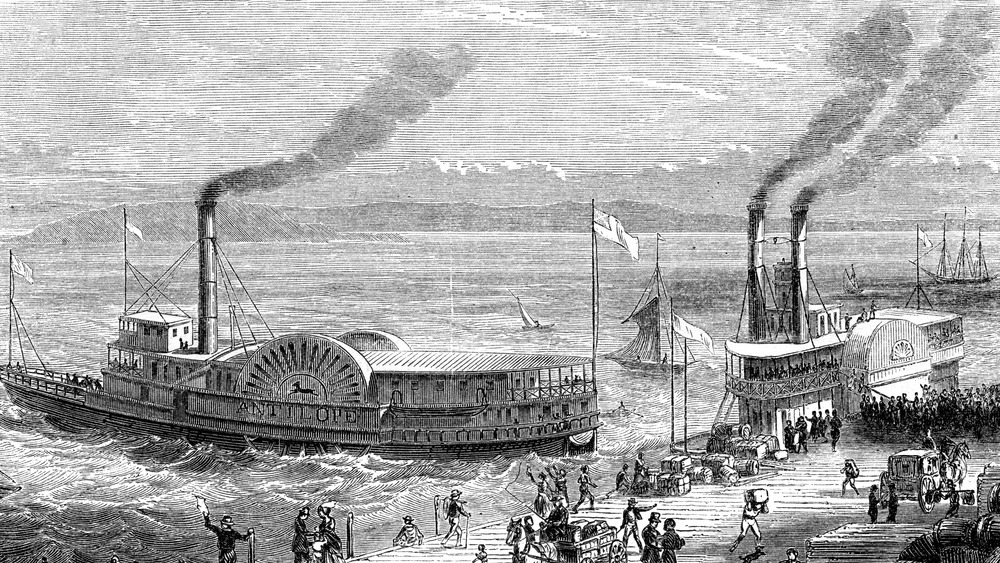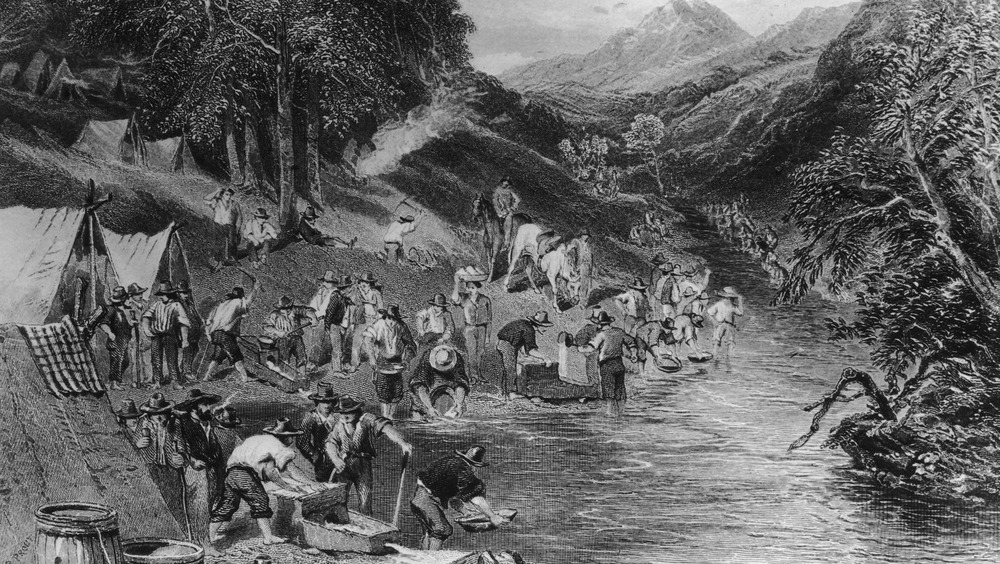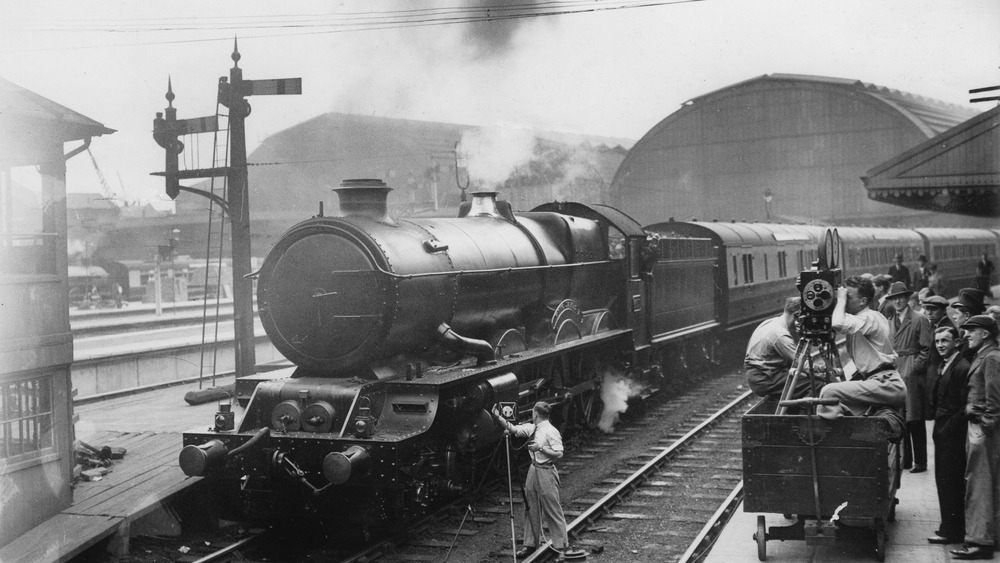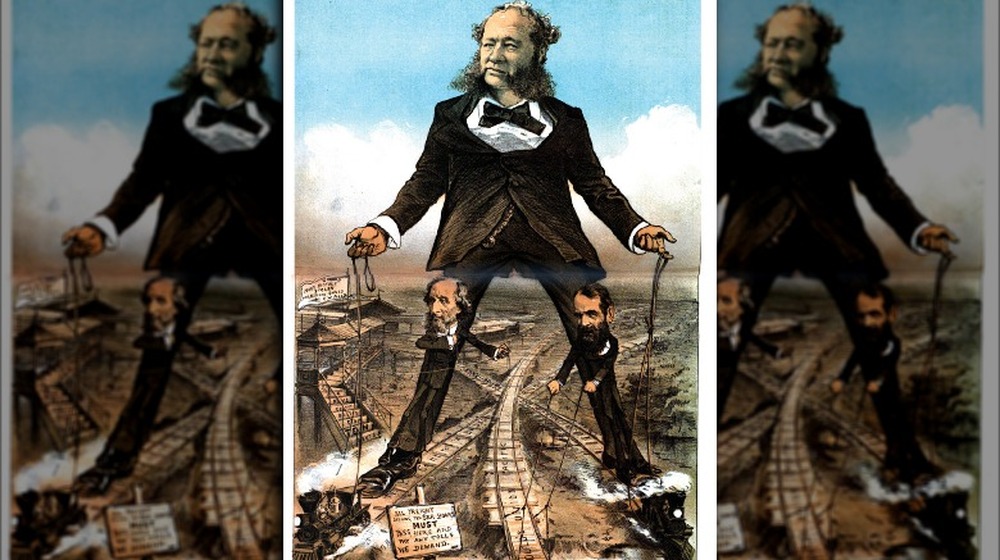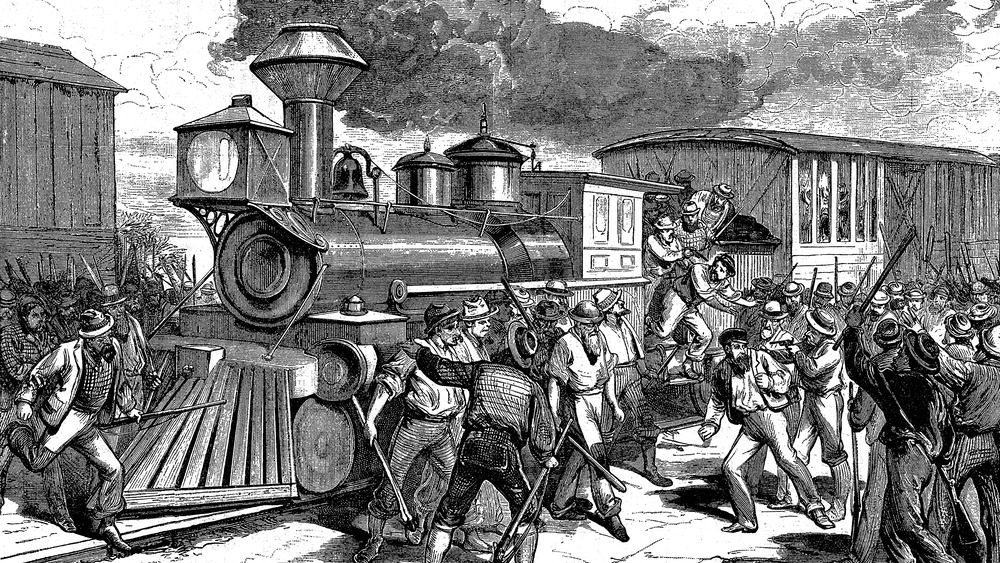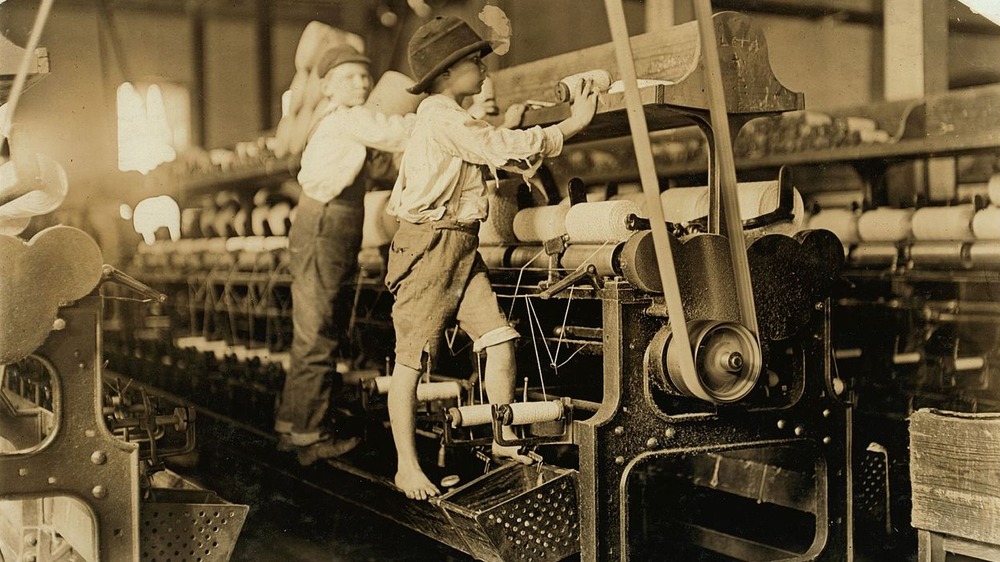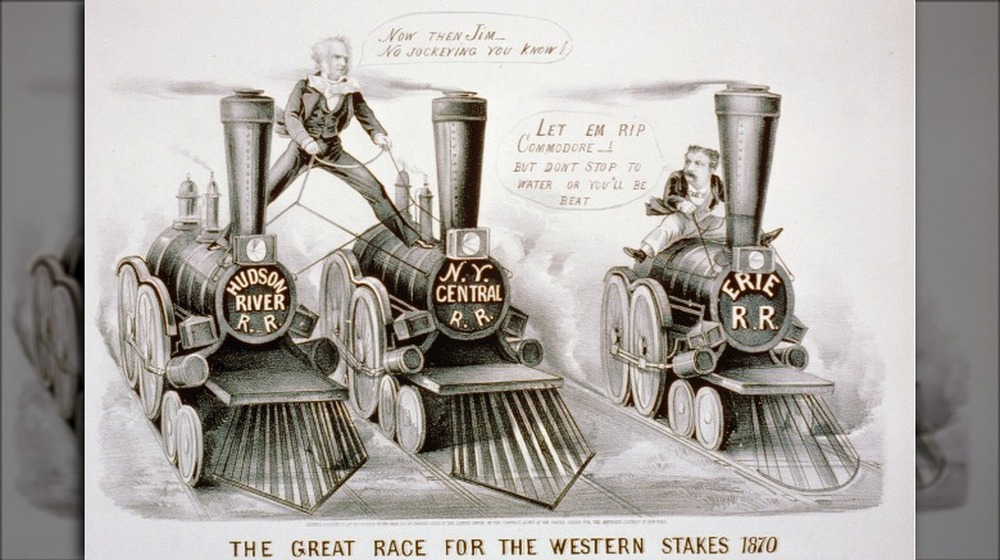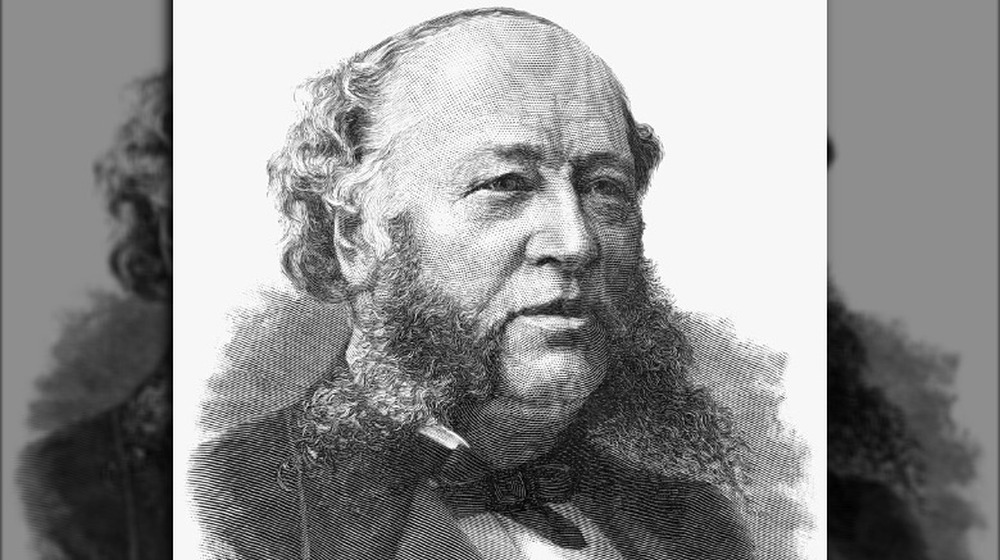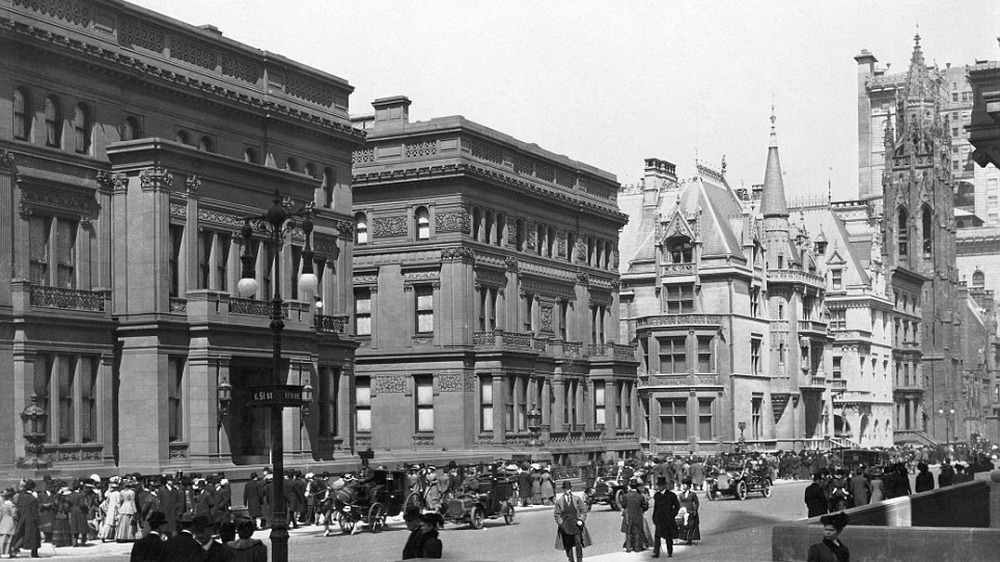How The Vanderbilt Family Really Got So Rich
So, the Vanderbilt family. There's a chance you've heard the name around somewhere. To hazard a guess, it's probably got something to do with the university of the same name — Vanderbilt University. But beyond that, well, the name doesn't show up all that often anymore, a couple decades into the 21st century, which probably makes the title of this article a little confusing. After all, who is this family anyway, and they're rich?
Well, they were rich. The richest — or, at least, one of the richest, anyway — families in America. For a time, the name was associated with massive wealth and influence, and that particular time was the Gilded Age of 19th century America, or the Industrial Revolution that exploded around and after the Civil War. Yeah, the name meant a lot around then, Vanderbilt being up there with Rockefeller, Carnegie, and Ford.
And a lot of that (though not all of it) had to do with the exploits of Cornelius Vanderbilt, a veritable titan of industry through the 19th century. He really went from rags to riches over the course of his life, but how? And also, if he supposedly amassed such a huge fortune, then what happened to it?
Cornelius Vanderbilt's early start
Born in New York in the late 18th century, Cornelius Vanderbilt (pictured) got his start in business early. As in, really early. As in, by age 11, when he started working with his father (via Biography). And this wasn't just some fluke or short employment; by the time he turned 16, he'd asked his parents for a loan to buy himself a boat and start getting into the shipping industry. The profits were split between him and his parents, and, well, the profits were impressive: $1,000 in just his first year, during which he was already proving his business acumen.
But things didn't start there. According to the Vanderbilt Museum, the War of 1812 started when Vanderbilt was just 18, and it ended up providing a pretty nice business opportunity. With forts popping up along the rivers in New York, leading a growing shipping empire was honestly the perfect position to be in. He managed to score contracts with the US government in 1814, where he was responsible for transporting troops and supplies between those forts.
To put it really simply, the venture was a massive success. By the end of the war, he had built up his own small fleet of ships and, oh right, about $10,000 in working capital. It's a pretty notable success, and that's even without mentioning the pretty cool nickname he got out of the whole thing: "Commodore."
Cornelius Vanderbilt turned to steamships as the next big thing
By 1818, the Commodore could see how things were about to change in the world of shipping, and he had no intention to be left behind in the dust, selling off his fleet of wind-powered ships and turning to something new: steamships (via The Vanderbilt Museum). According to Biography, he went to work with Thomas Gibbons on the Union Line, which ran steamships for shipping and trade between New York and New Jersey.
That's when he started to learn a thing or two about owning and running a large corporation, rather than just his own small shipping company, and that included the legal matters that came with the territory. See, Gibbons was technically violating a monopoly on trade which had been granted to Robert Fulton and Robert Livingston. The case ended up going to the Supreme Court, which ruled in favor of Vanderbilt and Gibbons; the monopoly didn't apply to interstate trade.
With his taste of big corporations, Vanderbilt went off on his own sometime in the late 1820s, as History says. He bought his own boats and set up his own new shipping lines running between Boston and New York, really putting pressure on his competition. And it was insanely effective. The business made him a millionaire by his mid-forties with over a hundred steamboats under his command.
The Gold Rush presented Cornelius Vanderbilt with an opportunity
Looking at the times when all of these things were happening to Cornelius Vanderbilt — early to mid-1800s or thereabouts — there are a couple big events there, too. The Civil War is one, but the really lucrative one for Vanderbilt was the California Gold Rush.
Come the late 1840s and early 1850s, prospectors were clamoring to head west, fantasies of gold and instant wealth in their minds. The problem was, of course, getting there. According to Encyclopedia.com, this was before the transcontinental railroad, so travelers had a couple options, both of which involved a bit of sailing. There was sailing around the tip of South America and Cape Horn (dangerous for its storms), or sailing down to Panama and trekking through the tropical jungle for the ride to San Francisco (dangerous for the possibility of malaria). Not great options, really.
That's where Vanderbilt saw an opportunity. In 1851, he made an agreement for exclusive rights to transport people across the Nicaraguan Isthmus, began offering trips from New York to San Francisco via his new route (via Biography), and charged half the price of his competition. Now, technically, the journey was still relatively dangerous, but the business venture was a resounding success. Within a year, he'd earned more than $1,000,000 — or about $26,000,000 adjusted for inflation (via History) — and rival companies were offering to pay him $40,000 a month if he would stop his operations.
Cornelius Vanderbilt's railroad empire
Alright, so Cornelius Vanderbilt was already making it pretty big with steamships and shipping, but the thing that really put him that much further over the top? The railroads. Railroads were a really big thing at the time. As the Library of Congress explains, around and after the Civil War, thousands of miles of rail were being laid, and not just at the behest of wealthy industrialists. No, the government was in on it, too, with Congress authorizing the use of public lands specifically for the building of railroad lines.
That said, wealthy industrialists were also a huge part. Vanderbilt left the shipping business, selling off his fleet around the 1860s to start making his way into railroads (via Encyclopedia.com). He used his already immense wealth to start buying up more and more of the individual rail lines in New York, merging them all into one, with the intention of controlling the entire rail network, according to ThoughtCo.
And again, the venture was a massive success. He didn't quite control every rail line, but he controlled enough to standardize procedures across a wide area, making the railways more efficient on top of that. And his success with the railroads was really evident in the creation of the Grand Central Depot; as Biography puts it, the terminal for the New York Central Railroad was a marvel with its elevated platforms and dramatic glass ceiling.
Cornelius Vanderbilt was fiercely competitive
Honestly, Cornelius Vanderbilt's success really had to do with the fact that the man was fiercely, terrifyingly competitive. To the point that T.J. Stiles' The First Tycoon: The Epic Life of Cornelius Vanderbilt recalls that he loved "competition for competition's sake" all while not really caring how many enemies he made in the process.
And that's accurate. He wanted to buy Thomas Gibbons' Union Line after his death, except that Gibbons' son wouldn't sell (via Biography). So he created his own Dispatch Line, charging low fares and heavily pushing marketing, all to be able to pull traffic away from the Union Line, forcing Gibbons' son to eventually buy him out. It was a tactic Vanderbilt used a lot, even against giants of the industry, like the Hudson River Steamboat Association. He undercut his competition's fares and called on the populist language that was big at the time, naming it the "People's Line." Long story short, the Association bought him out for $10,000, with a $5,000 annual payment. A couple rounds of this made him a millionaire.
It's also how he made his railroad empire. Vanderbilt was looking to own the New York Central Railroad, but they weren't looking to sell. One year, the Erie Canal froze over, meaning all shipping had to be done by rail, so Vanderbilt refused to let his rail lines take passengers or goods from the New York Central Railroad. Effectively cut off from western cities, they finally gave in, selling him controlling interest.
Low wages for workers
Alright, so there's been plenty about how Cornelius Vanderbilt was able to build himself multiple different empires in multiple different industries, all largely as a result of his own drive and ambition. He was competitive with a keen sense for business to match, but it's worth bringing up that not all of the ways he managed to make money were quite so savory.
After all, this was the Industrial Revolution; it wasn't really kind to the everyday worker. Low wages and horrific working conditions were just part of the era (via Legends of America). And that was true of the railroads, too; according to The Atlantic, the normal wage for a man working on the railroad was a pitiful 75 cents a day. That's next to nothing, especially compared to the millions in the pocket of the Vanderbilt family. It also feels like it lines up with something that Vanderbilt's son, William Henry Vanderbilt, said to the press: "The public be damned." They only really cared about their stockholders and investments (via Encyclopedia.com).
It was bad enough to culminate in the Railroad Strike of 1877. As told by Case Western Reserve University, the strike came as a result of a 20 percent wage cut to the workers. William Henry Vanderbilt responded by saying the cuts were a result of the bad economy, but that didn't appease the workers. They demanded compensation and restored wages, threatening to strike again; Vanderbilt did nothing about it in the end.
A lack of government regulation
Take a look at the standard of living for the working class during the Industrial Revolution, and it sort of paints a picture of just how wealthy industrialists became as wealthy as they did. According to Legends of America, most people moved into cities for factory jobs, only to be greeted with incredibly dangerous working conditions for next to no pay despite long hours, before going home to live next to open sewers that just festered with disease. Women and children weren't excluded from that either (child labor was a very real and very messed-up problem of the time), and unions wouldn't really start taking hold until the late 19th century.
Basically, the government wasn't really on the side of the working class; they definitely sided with corporations. As History explains, the government worked to keep foreign competition out of the picture, giving industrialists the chance to create monopolies while facing few consequences. (Honestly, maybe that's also because plenty of politicians were easily bribed, gladly helping out their friends with deepest pockets, making sure legislation favored big business over the everyday worker).
And even where rampant corruption wasn't involved, there was ignorance. Encyclopedia.com says that Cornelius Vanderbilt wasn't above manipulating the stock market as he saw fit, he and other business owners selling stocks at inflated and unwarranted prices, simply because the government regulation wasn't there to tell them to stop.
The Erie Railroad War
Alright, so given that Cornelius Vanderbilt was scarily competitive and very much in a position to take advantage of the leeway granted to him by the government, there's a pretty good example of how this all came together. Namely, it's his rivalry with Daniel Drew. Drew owned some of the railroads in New York which Vanderbilt looked to buy, and he didn't want to sell. So he issued fake, nonexistent stocks...all of which Vanderbilt bought anyway, using some very convenient political ties to have the stocks recognized as real, giving him ownership of the line (via Encyclopedia.com).
That rivalry culminated in the Erie Railroad War. According to ThoughtCo, Drew also owned the small (and not super profitable) Erie Railroad and had allied with Jay Gould and Jim Fisk. Vanderbilt wanted the line to complete his hold over the New York railways. Drew again used his old tactic, selling watered-down stocks to Vanderbilt, who knew exactly what was happening and kept buying anyway. He was betting on his own fortune to outlast his opponent's strategies, essentially just planning on out-stubborning Drew.
The gamble nearly bankrupted him, but it worked out. A judge got involved, and in the end, Vanderbilt called a meeting with the other men. The exact details aren't known, but Gould and Fisk ended up with the Erie Railroad, only to have to buy back some of Vanderbilt's watered-down stock. As for Drew? He was forced out of the company entirely.
Philanthropy? Why not keep the money?
By the time Cornelius Vanderbilt died in early 1877, he'd amassed a fortune of around $100 million (via History), and obviously a big part of that is how he made that money. But, in the case of Vanderbilt, part of it is how he kept that money. Because compared to his contemporaries, Vanderbilt really didn't spend all that much. Fellow industrialists like Andrew Carnegie and John D. Rockefeller were known for being philanthropists on top of being corporate tycoons. (That's not to say that the two weren't also wealthy; the Rockefeller family is still insanely rich over a century later). Vanderbilt really had no plans to give to charitable causes; his main philanthropic venture was a $1 million endowment to the school that would eventually rename itself to Vanderbilt University.
And he didn't really spend much on himself either, generally having little eye for ostentation, as Biography says. He preferred to live modestly. Well...relatively modestly. Yes, he did send his family on an expensive tour of Europe and spend on racehorses; his house was also fairly large, though not extravagant.
Again, it's not like he didn't spend anything, but this is all kept in perspective, compared to the opulent things wealthy people could and do spend on. For that matter, his own family spent more than him; the Vanderbilt family has had a number of mansions connected to their name, all of which were the work of his descendants.
Vanderbilt's son was no slouch, either
A lot of the wealth of the Vanderbilt family can be attributed to the ventures of Cornelius Vanderbilt, but he isn't the only one in the family to deserve recognition. Cornelius Vanderbilt had a lot of kids, but the main one involved in the whole family fortune story was William Henry Vanderbilt (pictured). And that might've sounded like a shock at the time; according to the New Netherland Institute, Vanderbilt thought little of his son, seeing him as frail and unambitious. But a year at one of the family farms proved otherwise, and Vanderbilt saw his son improve the farm to the point that it was suddenly profitable.
Seeing promise, he placed his son in charge of a formerly failing railroad, which ultimately became stable, bringing in profit. The younger Vanderbilt eventually became vice president of multiple branches, then the inheritor of the entire company (and most of the family fortune) after the death of his father.
William Henry Vanderbilt proved he was a lot like his father, stretching the railroads out further to the west while also expanding their already existing operations in New York. He fought the same sorts of wars against rivals, and in just 10 years, managed to double the family's already massive fortune. In other words, by the time of his death in the 1880s, the estate was worth about $200 million — that's $52 billion in today's money.
The fall of the Vanderbilt family
The Vanderbilt family's wealth wasn't fated to last very long, and compared to other titans of the Industrial Era, their star fell fast. Fortune's Children: The Fall of the House of Vanderbilt by Arthur T. Vanderbilt II paints a pretty vivid picture of how things declined.
The Vanderbilt family started to make decadent shows of their wealth, building huge mansions on Fifth Avenue that were monuments to splendor. The first was built in 1883, but within 70 years, all of them had been destroyed. Thirty years after the death of Cornelius Vanderbilt, the once-richest family was nowhere near that title anymore. Within a century of his death, none of his descendants were even millionaires. (In comparison, members of the Rockefeller family still rank among the richest in the US).
So then...what happened? Forbes lists a few things. Philanthropy is one; William Henry Vanderbilt was actually considerably more philanthropic than his father (via New Netherland Institute), and his descendants followed that pattern. Others would spend exorbitant amounts on gambling and mingling with high society, paying more attention to luxury than business. Plus, as the generations went on, the fortune was split more and more ways. But even if the family didn't spend as much — even without those other problems — railroads just weren't profitable anymore. The shipping part of the industry was already declining; the greater use of cars, trucks, and planes by the mid-20th century ended up being the final nail in the coffin.
